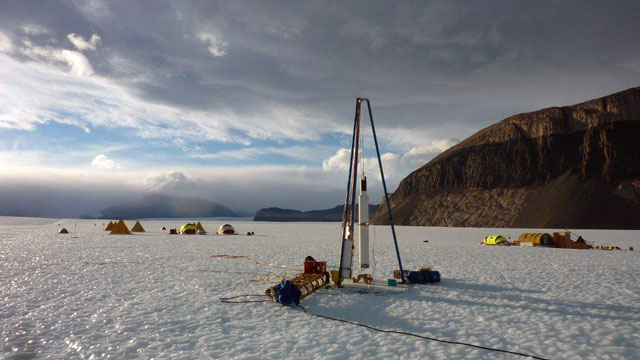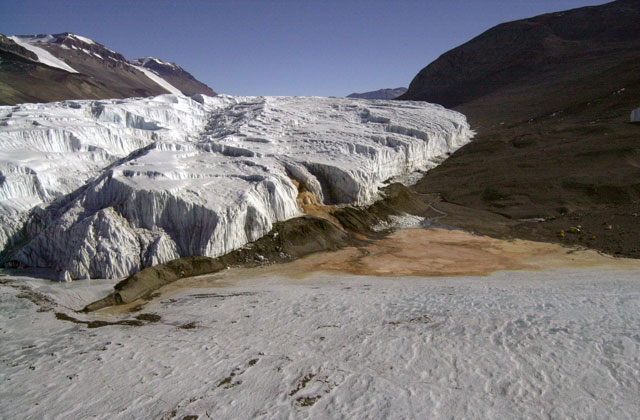|
Page 2/2 - Posted August 31, 2012
ASPA designation for Blood Falls comes as interest heats up over subglacial systemsThe ASPA designation for the subglacial ecosystem comes at a time when scientists are racing to learn more about the lakes and related hydrology under Antarctica’s ice sheets. Last year, Russia finally penetrated more than three kilometers through the ice sheet into Lake Vostok, the largest of some 300 subglacial lakes believed to exist. Meanwhile, the British Antarctic Survey (BAS) “This set a precedent in the Treaty, and that’s what made it interesting, too,” said Polly Penhale, environmental officer for the NSF’s Office of Polar Programs Harris said progress toward protecting other subglacial environments such as the hidden lakes of Antarctica has already taken place through the National Research Council (NRC) 
Photo Credit: Tanner Kuhl
A research team works on the surface of Taylor Glacier to retrieve ice cores.
Taylor Valley and its namesake glacier are among the most heavily researched regions in Antarctica. Previous studies around and on the glacier have involved activities such as using chainsaws to cut artificial caves into the ice and extracting horizontal ice cores right at the surface of the glacier that may hold clues to ancient climate. “About everything has been done on Taylor Glacier at some point,” Biletnikoff noted. Blood Falls had been designated a “special feature” when the Dry Valleys Antarctic Specially Managed Area (ASMA) was created in 2004. The ASMA designation generally encompasses broader areas than an ASPA, with detailed plans of how various activities within the area should be conducted. A permit is not required to enter an ASMA. The Dry Valleys ASMA was significantly revised last year, and the somewhat ambiguous “special features” designations were discarded in favor of various types of zones for particular activities. Blood Falls and Taylor Glacier met the criteria for a Scientific Zone. Adding the extra layer of protection afforded by the ASPA guidelines helps ensure that other scientific or operational activities won’t contaminate the alien-like environment below the glacier. “We didn’t want to make a Restricted Zone,” Biletnikoff said. “We didn’t want to make an area that is ripe for scientific opportunity to be completely closed off. There may be tremendous value of what’s found there in the future.” Instead, any major activities involving the Blood Falls region in coming years will involve environmental impact assessments and thorough consultations with the scientific community, according to Biletnikoff. “It really becomes a federal review process based on the best science that is out there,” he said. It took about 2½ years to complete the formal ASPA process, though discussions on adding Blood Falls and part of Taylor Glacier to the protected list had started in earnest in 2008, Biletnikoff said. The Lower Taylor Glacier and Blood Falls ASPA, the first proposed by the United States since 2005, included far more involvement from the research community than in the past. That was appreciated by scientists like Mikucki. “The diligence that the committee took pulling together the ASPA is commendable,” she said. “They made sure to include all interested parties from the beginning. This is a positive example about how scientists can work together with environmental managers to help preserve the precious places we study.” Biletnikoff said he expects that model will continue to be used in future ASPA proposals. “It was quite thrilling in the end to go through a fully vetted process,” he said. “We have better protocols in place now to make sure one type of science isn’t jeopardizing another in the future.” Harris credited former ERA employee Rachel Carr, now pursuing a doctorate in glaciology at Durham University, for the role she played in the development of the Taylor Glacier and Blood Falls ASPA plan. “The range of scientific issues and their technical complexities, and the consequent scientific debate that arose, made this a particularly challenging plan to construct, and it took a lot of effort by many people,” he said. “Reaching a consensus on the approach was therefore most rewarding, and hopefully will ensure that the values of this remarkable feature will be secured for the long term.” |



For USAP Participants |
For The Public |
For Researchers and EducatorsContact UsU.S. National Science FoundationOffice of Polar Programs Geosciences Directorate 2415 Eisenhower Avenue, Suite W7100 Alexandria, VA 22314 Sign up for the NSF Office of Polar Programs newsletter and events. Feedback Form |



